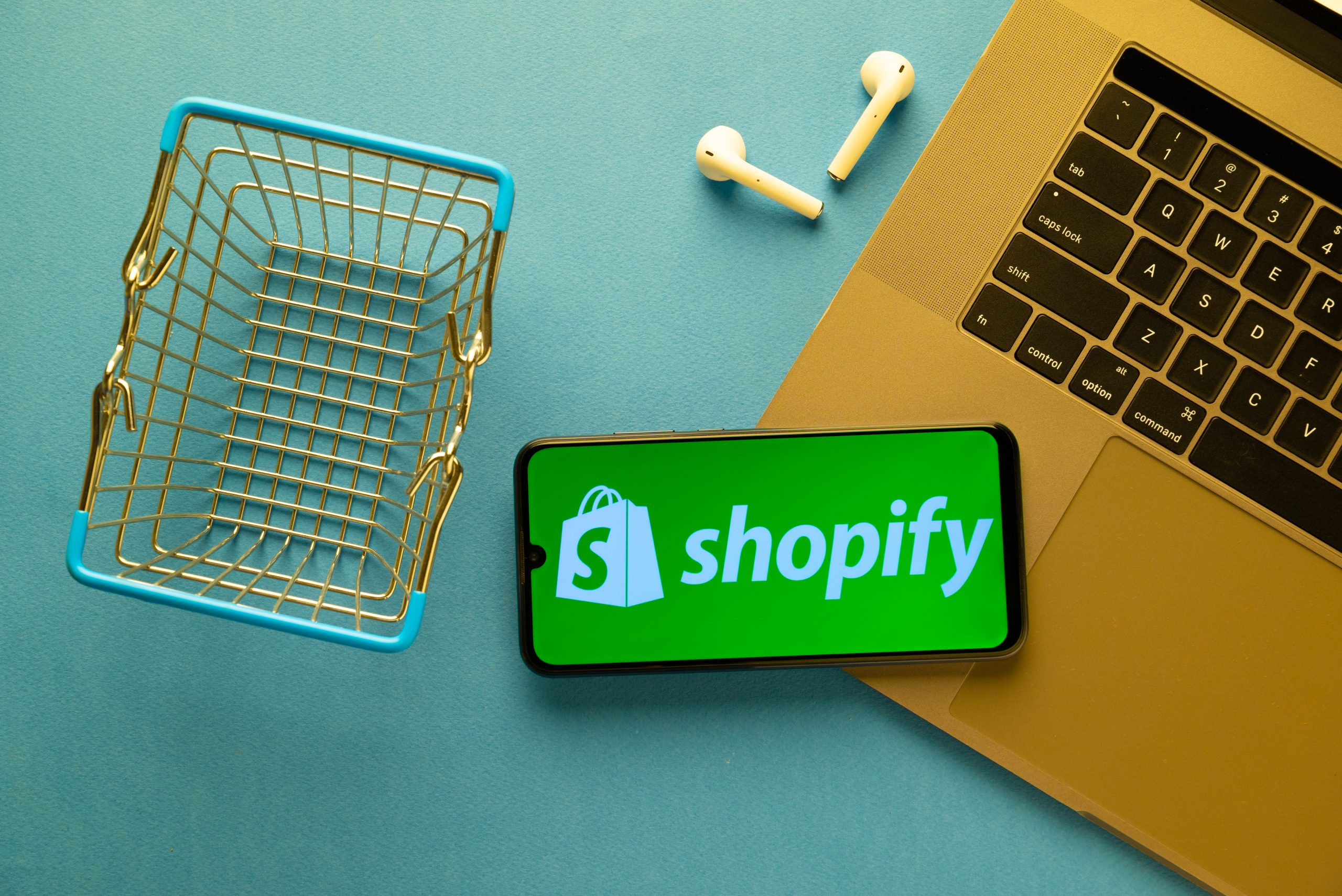E-commerce platforms have revolutionized the way of marketing in the last decade. Online businesses have grown significantly with the introduction of new marketing strategies. Shopify is one such example that has stayed at the forefront of this growth chart.
Curious about the secrets behind their e-commerce success? This case study dives into Shopify’s triumph, dissecting its marketing mix, SWOT analysis, target audience, marketing strategy, and digital footprint.
Let’s go deeper into the world of Shopify!
Shopify and its Journey So Far
Shopify, a multinational Canadian e-commerce company, embodies a simple premise: “Empowering anyone, anywhere to launch their own e-commerce website.“

Initially established to facilitate online sales of snowboarding equipment, it was constructed using an open-source web application framework. Founded by its creators, Snowdevil was rebranded as Shopify in June 2006, subsequently lending its name to their e-commerce platform.
Shopify facilitates the establishment of your online brand through an e-commerce store and a personalized domain. Functioning as e-commerce software, it provides tools to monitor sales patterns, manage inventory, customize the appearance of your online store, and integrate various sales channels. Shopify attracts thousands of experienced business professionals and newbie entrepreneurs to invest and earn.
Shopify’s Business Model
Shopify adopts a platform-based business model. It serves as a platform that empowers users to establish online stores for selling their products. By equipping businesses with essential tools, Shopify facilitates their connection with consumers through the creation of e-commerce websites.

Shopify is a versatile platform that offers a range of services to facilitate the establishment and operation of e-commerce stores. Below are a range of solutions it provides on its platform to its users:
- Building a storefront: Easy and fast option for creating an online store
- Store Management: Manage customer profiles, orders, and interactions
- SEO and Marketing: Build a web presence for your store and run marketing campaigns
- Product Inventory: Easy product tracking and distribution
- Web Hosting: Quick & reliable hosting with instant updates
- Dashboard & Analytics: Report and review your store activity
- 24/7 Support: A dedicated team of experts to help you
Target Audience
The target audience encompasses a specific demographic or group of individuals who exhibit an interest in your product or have the potential to become future purchasers. Shopify caters to all retailers in the process of creating their websites. The platform offers services tailored to various revenue brackets through a range of subscription plans. They provide specialized services, distinguishing between different industries and retailers.
Shopify’s target demographic encompasses a diverse range of individuals and enterprises seeking to initiate, operate, and expand their online storefronts. Here are distinct segments within Shopify’s target audience:
- Entrepreneurs and Small Business Proprietors
- E-commerce Retailers: Both B2C (business-to-consumer) and B2B (business-to-business) enterprises
- Startups and Newly Established Ventures
- Creative and Artistic Enterprises
- Specialized and Niche Retailers
- A Worldwide Customer Base
Shopify reaches customers by enabling them to independently create e-commerce websites. Customers using Shopify can sell their products worldwide without any geographical restrictions.
Shopify’s Marketing Examples
Shopify employs a range of effective marketing strategies:
- They focused on empowering small merchants with e-commerce tools rather than relying on brand ambassadors, leading to the creation of a thriving ecosystem in 2009.
- The launch of Shopify Mobile in 2010 revolutionized mobile commerce, capitalizing on the increasing use of smartphones for shopping.
- Shopify initiated the “Build a Business” competition to encourage entrepreneurs, offering substantial rewards and mentorship for successful ventures.
- Recognizing the need for expert support, Shopify introduced Shopify Experts in 2011, connecting experienced professionals with less seasoned sellers.
- In 2011-2012, Shopify experienced significant growth, with a 61% increase in new stores and over 2.2 times growth in sales.
- The major platform redesign, Shopify 2, was unveiled in 2013, incorporating over 60 new features.
- Shopify revamped its app in 2014 to accommodate offline sales, integrating Shopify Mobile with Point of Sale (POS) systems.
- “Buy Buttons” were introduced in 2015, allowing users to promote content from various websites, expanding beyond e-commerce storefronts.
- In 2016, Shopify integrated with Facebook Messenger to provide a more personalized and direct channel for merchants to interact with customers.
- Shopify bridged the gap between online and offline shopping in 2017 with the introduction of Shopify QR codes, allowing customers to access physical objects through their smartphone cameras.
- Shopify utilizes social media platforms, including YouTube, for company promotion.
- They also leverage Instagram and Facebook, applying psychological theories like Reciprocity theory to their marketing efforts.
These strategies have contributed to Shopify’s success in the e-commerce market.
Marketing Strategies
Shopify employs a comprehensive array of marketing strategies to bolster its presence and attract a diverse range of users:
Content Marketing
This involves the creation of valuable and educational content spanning blog posts, e-books, guides, and video tutorials. Through its dedicated blog, “Shopify Compass,” the company aims to educate and empower entrepreneurs in areas pertinent to e-commerce and online business.
Social Media Marketing
Shopify maintains dynamic profiles across prominent social media platforms like Facebook, Twitter, Instagram, and LinkedIn. Through these channels, the company disseminates updates, showcases customer success stories, and shares promotional content to engage its audience effectively.
Email Marketing
Shopify leverages email communication to nurture leads, engage existing clientele, and highlight its products and services. This channel is utilized to send out newsletters, provide product updates, and extend exclusive promotional offers.
Affiliate Marketing
By establishing an affiliate program, Shopify incentivizes individuals and businesses to refer new customers to its platform. This mutually beneficial arrangement encourages affiliates to actively promote Shopify to their respective audiences.
Search Engine Optimization (SEO)
Shopify places a strong emphasis on optimizing its website and content to enhance visibility in organic search results. This strategic approach ensures that potential users readily discover Shopify when seeking e-commerce solutions.
Pay-Per-Click Advertising (PPC)
Through targeted advertising campaigns on platforms like Google Ads and various social media networks, Shopify effectively reaches potential customers by focusing on specific keywords and demographics.
Partnerships and Collaborations
By forging partnerships with other companies, influencers, and agencies, Shopify expands its network and credibility. Such collaborations may involve joint marketing initiatives or integration with complementary services.
Community Building
Shopify nurtures a vibrant community comprising entrepreneurs and sellers who utilize their platform. Engagement with this community occurs through forums, meetups, conferences, and events, fostering relationships and providing valuable support.
Free Trials and Discounts
Shopify offers free trials to prospective users, enabling them to experience the platform firsthand before committing. Additionally, occasional discounts and special offers serve as incentives to encourage sign-ups.
Referral Program
Through a structured referral program, existing customers are empowered to refer others to join the platform. Successful referrals yield rewards or credits, further motivating users to advocate for Shopify.
User-Generated Content
Shopify actively encourages its user base to share their success stories and experiences utilizing the platform. This user-generated content serves as powerful social proof and is often integrated into marketing materials.
Influencer Marketing
Collaborating with influencers and thought leaders within the e-commerce and entrepreneurship realms, Shopify effectively garners endorsements for its platform, leveraging these partnerships to reach a wider audience and enhance its brand credibility.
Shopify’s SWOT Analysis
SWOT Analysis serves as a vital organizational tool for assessing Strengths, Weaknesses, Opportunities, and Threats. It provides valuable insights into areas of proficiency and areas for potential enhancement. Here is a comprehensive SWOT Analysis for Shopify:

Strengths of Shopify
Shopify has secured a significant 18% share in the eCommerce industry, owing to several key strengths:
- Diverse Product Range: Shopify boasts a wide array of products, underpinned by dependable suppliers, establishing a robust foundation for the company.
- Strategic Mergers and Acquisitions: The incorporation of new technologies through strategic mergers and acquisitions has fortified Shopify’s position in the market.
- Expansive Portfolio: A strong portfolio has empowered Shopify to diversify into new product categories. This growth has been bolstered by commendable customer and merchant experiences.
- Robust Distribution Channels: Shopify benefits from a network of robust distribution channels and an engaged dealer community. These partners not only promote the company’s products but also offer valuable training to the sales team.
Weaknesses of Shopify
While Shopify is a prominent player in the market, some areas require improvement to maintain its competitive edge:
- Employee Training and Development: Investments are needed in the training and development of employees to keep them updated with evolving technologies, thereby ensuring consistent market penetration and reduced attrition rates.
- Substantial Technological Investments: Sustaining an up-to-date technological infrastructure demands significant investment. Shopify must allocate resources to remain current with industry best practices.
- Challenges in Product Range Expansion: Despite being an industry leader, Shopify encounters challenges when venturing into new product segments.
Opportunities for Shopify
To cement its position as the market leader, Shopify must leverage the following opportunities:
- Leverage New Technologies for Pricing Strategy: Adoption of emerging technologies can facilitate the implementation of innovative pricing strategies.
- Increased Investment in Marketing and Branding: Augmented investment in marketing and promotional activities will boost brand awareness and bolster sales.
- Post-Pandemic Digital Transformation: With the surge in demand for online presence post-pandemic, Shopify is poised to attract a wave of new customers seeking to establish their digital footprint.
Threats to Shopify
In the dynamic tech industry, Shopify faces certain potential threats that warrant careful consideration:
- Skills Shortage in the Market: The scarcity of skilled professionals in the job market poses a significant threat to Shopify’s ability to recruit and retain top talent.
- Technological Advancements by Competitors: The risk of competitors outpacing Shopify through the development of cutting-edge technologies remains a formidable challenge.
- Shifts in Customer Behavior due to Social Media Changes: Alterations in customer behavior driven by new features on social media platforms present a potential disruption to Shopify’s market presence.
Key Takeaways
In this blog post, we delved into an understanding of Shopify, its marketing mix, and how it strategically leverages the 4Ps to its advantage.
Additionally, we explored the competitive landscape surrounding Shopify. It is evident that Shopify stands as a dominant force in the eCommerce industry, adeptly employing a diverse range of marketing strategies to maintain its position at the forefront.
Capture the rightful attention of your target audience with the right email marketing strategy. Visit our website to find out more or call us today!
All images belong to their respective owners. Please email [email protected] if removal is required.




